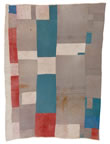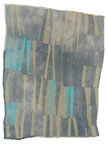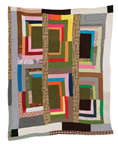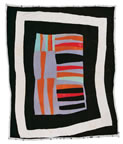*These 3 quilts were made by members of the Pettway family, more history and images can be seen here: http://www.auburn.edu/academic/other/geesbend/explore/catalog/slideshow/index.htm*
A few years ago, I had the great privilege of seeing an exhibit of quilts at the High museum that were made by the women of Gee's Bend, Alabama. I can honestly say that I have never been so emotionally moved and, at the same time, creatively intrigued by an art experience. These quilts were some of the most interesting graphic pieces I had ever seen, and were equally personal. To me, this is the ultimate combination in art, and not easy to achieve. It's amazing that these folk-art quilts - made from old clothing for keeping warm, by women who lived in a tiny, rural, poverty-stricken, isolated community - could rival any modern masterpiece hanging in any museum today.
 Another Pettway piece, lovingly made by a mother and daughter using work clothes from the father, who had passed on.
Another Pettway piece, lovingly made by a mother and daughter using work clothes from the father, who had passed on.
Here's a little info about Gee's Bend: this small community in South Alabama was once a cotton plantation. It is almost completely surrounded by a bend in the Alabama River. There was no school there until the 1940's, and the people who live there are descendents from emancipated slaves, who continued farming the land and eventually purchased it from the government. Quilting is a skill handed down from generation to generation and is still enjoyed in the community to this day. The beauty of these quilts became known through photographs taken for a government study, and ever since, these quilts have adorned the walls of many museums around the world.
For our lesson, we began with a viewing and discussion of the style of the quilts, and how they were different from some traditional quilting styles, where symmetry and repetition are more common, as seen here:

Each 3rd grader made two quilt squares from paper, attempting to represent an article of clothing or other piece of cloth from their memory - a favorite dress, a baby blanket, a father's tie. Then we cut our squares into sections and traded within our classroom community in order to get a variety of patterns and colors. We pieced the sections together in interesting ways, keeping in mind the asymmetrical patterning of the Gee's Bend quilts. Finally, we titled our quilts with a meaningful name. Here are some pics of our process and results.
 |
| creating "quilt squares", inspired by fabrics from our personal memories |
 |
| trading our squares within our classroom community |
 |
| a beautiful, colorful collection of our own work and our neighbors' |
 |
| Assembling the final designs... |
 |
| I can see that their Matisse influence is still lingering from 2nd grade... |
 Another Pettway piece, lovingly made by a mother and daughter using work clothes from the father, who had passed on.
Another Pettway piece, lovingly made by a mother and daughter using work clothes from the father, who had passed on. Each 3rd grader made two quilt squares from paper, attempting to represent an article of clothing or other piece of cloth from their memory - a favorite dress, a baby blanket, a father's tie. Then we cut our squares into sections and traded within our classroom community in order to get a variety of patterns and colors. We pieced the sections together in interesting ways, keeping in mind the asymmetrical patterning of the Gee's Bend quilts. Finally, we titled our quilts with a meaningful name. Here are some pics of our process and results.
Each 3rd grader made two quilt squares from paper, attempting to represent an article of clothing or other piece of cloth from their memory - a favorite dress, a baby blanket, a father's tie. Then we cut our squares into sections and traded within our classroom community in order to get a variety of patterns and colors. We pieced the sections together in interesting ways, keeping in mind the asymmetrical patterning of the Gee's Bend quilts. Finally, we titled our quilts with a meaningful name. Here are some pics of our process and results. 




















I love this project.
ReplyDeleteYour students interpreted the patterns beautifully.
Hope, these are gorgeous! Such an impressive lesson coupled with an incredibly creative outcome. You really are a Master Teacher. Your kids are lucky to be in your class! Wow!!!!
ReplyDeleteSo Beautiful Hope! I love how you incorporated a community aspect with the trade of "quilt blocks".
ReplyDeleteThis is fabulous! I am wondering what size paper did students use originally? Where the two pieces the same size or different? Also, how do you instruct students to put the pieces together if they were all different sizes?
ReplyDeleteThe students began by making two quilt "squares", each were 9x12". Then we cut them both inhalf and saved one half of each. We cut the remaining halves again so that each kid had 4 small pieces (4.5x6") to trade. After the trade, they each had their two original pieces (6x9) and 4 new pieces, and we arranged all of them into one 9x12" rectangle. Some had to be trimmed and overlapped in order to make them all fit. A slightly larger rectangle might be better, but I needed to keep them 9x 12 for display purposes. It was really fun!
ReplyDelete